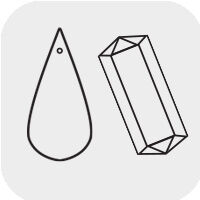Aquamarine
Meaning and Properties
Aquamarine History
Aquamarine, a splendid blue gemstone whose name originates from the Italian word for seawater, embodies the splendor of the sea. A member of the beryl family, aquamarine is a sister to the rich green emerald. It can be found in a range of pale blue hues and aqua green colors. Legends refer to aquamarine as the treasure of Atlantis.
There is much lore about the aquamarine stone. For instance, the Romans believed that if a frog were carved onto an aquamarine stone, it would reconcile enemies and make them friends. The Greeks and the Romans revered the aquamarine as a sailor's stone of protection and it was commonly worn to ensure a safe and prosperous passage across stormy seas. The Sumerians, Egyptians and Hebrews also admired and valued aquamarine gemstones.
Belief in aquamarine's powers of revelation was strong during the middle ages. It was common to carve gazing balls for fortune telling or to suspend an aquamarine crystal on a string over a bowl of water in order to divine messages as the stone disturbed the surface or touched letters drawn on the bowl's rim.

Dive into the beauty of aquamarine with our special guest, in-house graduate gemologist Dev. He shows how to test to specific gravity and how to make a simple aquamarine pendant you won't want to miss.
Aquamarine Metaphysical Properties
In the language of gemstones, aquamarine represents happiness, hope and everlasting youth. In ancient times, aquamarine was thought to protect those at sea. It was believed to make sailors fearless and safe from adversaries on the open waters. As far back as 480 BC, aquamarine was considered to be the treasure of the mermaids because its ability to protect increased when immersed in water.
Today, aquamarine is still thought to bring protection to those at sea and is a popular gift among ocean travelers. On land, it is believed to have soothing effects on couples, helping them to work through their differences and ensure a long and happy marriage. That power makes it an excellent stone to give on anniversaries.
It is also considered to be the stone of courage and preparedness and is believed to help maintain balance and order. Aquamarine is often used as a "good luck" stone, thought to bring feelings of peace, love, joy and happiness to those who wear it. There is an energizing quality to aquamarine that provides harmony and balance. If you dream of aquamarine, it is said that you will make new friends, and wearing earrings of aquamarine are thought to bring love and affection into your life.
Traditionally, aquamarine is also the birthstone for March.
Aquamarine Geological Properties
Aquamarine is a beryl—a relatively rare silicate mineral found in igneous and metamorphic rocks around the world—and a blue-green sister to the deep green emerald. Other beryl stones include morganite (pink), heliodor (yellow/yellow-green), goshenite (colorless) and maxixe* (deep blue). Aquamarine gems are frequently less included or fractured than emeralds, making larger stones easier to find.
Color and clarity are key to the value of gemstone aquamarine (with low grade beryl often refined into the metal beryllium). Color is a defining aspect of this gemstone, which is why most aquamarines are heat-treated to remove yellow tones and enhance the bright blue hues in this stone.
The natural blue and green colors of aquamarine come from ferrous iron and metallic ions. Aquamarine gemstones are found in a number of exotic places including Nigeria, Madagascar, Zambia, Pakistan and Mozambique, and the most brilliant blue varieties of the gemstones available today come from Brazil.
*Maxixe is pronounced "mashish."
| Al2Be3(Si6O18) | |
Proper Care of Aquamarine
Although aquamarine is a hard 7-1/2 to 8 on the Moh's scale, natural inclusions could make it vulnerable to breaking if exposed to extreme temperature changes or sharp blows. Do not use heat to clean aquamarine. Prolonged exposure to sunlight could fade color.
To learn more about aquamarine and other gemstones, order your copy of Walter Schumann's revised and expanded edition of Gemstones of the World.
Designing with Aquamarine
While it was once fashionable to wear the sea-green color most commonly associated with aquamarine, today's consumers prefer shades of sky or deep blue. Because of this, aquamarine is routinely heat-treated to remove the naturally occurring green component. This is a highly sensitive and precise process requiring that the stone be heated between 725 and 850 degrees Fahrenheit. If the stone is overheated, it will permanently lose all its color.
The elegant gemstone, aquamarine, stands proudly alone or can be lightly accented with gold toned beads and focal points. Aquamarine looks stunning with bright yellow gold metals, creating designs of warmth and bright cheer. The arctic blue and sandy tones of aquamarine gemstone beads look fresh when paired with the subdued colors of tourmaline, dyed cultured freshwater pearls and citrine gemstone beads. It also looks stunning when paired with smoky quartz or deep garnet gemstone beads.
The wonderful range of blues found in aquamarine complement just about any skin tone, and when worn as earrings and necklaces can show off the color of your eyes to advantage. Designer artists also like incorporating aquamarine with quartz crystal beads for soft, feminine Expression Jewelry™.
Why limit this gem to jewelry?
Aquamarine is a perfect embellishment for a variety of accessories including barrette clips, scarves and headbands, offering versatility to your wardrobe. Combine with faceted rondelle Czech fire-polished glass beads or crystal beads wired, glued or stitched onto any type of hair accessory for added sparkle, or dangle strands with fastened bead clusters to liven up crocheted scarves.
View more resources featuring aquamarine, including Design Ideas, Videos, Tutorials and more!
Shop for Aquamarine
**Please note that all metaphysical or healing properties listed are collected from various sources. This information is offered as a service and not meant to treat medical conditions. Fire Mountain Gems and Beads® does not guarantee the validity of any of these statements.
How did you like this resource? Your feedback helps us provide resources that matter to you most.
Copyright Permissions
All works of authorship (articles, videos, tutorials and other creative works) are from the Fire Mountain Gems and Beads® Collection, and permission to copy is granted for non-commercial educational purposes only. All other reproduction requires written permission. For more information, please email copyrightpermission@firemtn.com.



